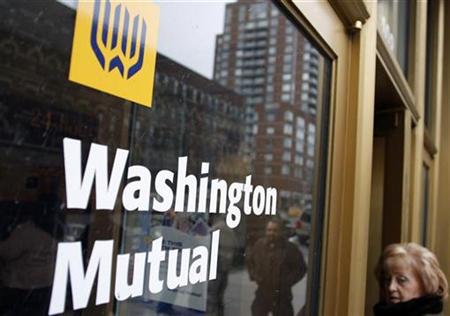
WaMu’s Bloated Asset Values Don’t Fool Investors
July 30 (Bloomberg) — With goodwill like Washington Mutual Inc.’s, it’s no wonder investors are getting such bad feelings about the company’s finances. Shares of the Seattle-based savings and loan have fallen 89 percent the past year to $4.43, leaving the company with a $7.6 billion stock-market value. The stock’s plunge must be a horrible mistake if we are to believe the values WaMu attributes to the assets on its balance sheet.
Consider the intangible asset known as goodwill, which is the bookkeeping entry a company records when it pays a premium price to purchase another company. As of June 30, WaMu said its goodwill was worth $7.3 billion, which is almost as much as the market now says the entire company is worth. WaMu hasn’t written down any of this asset since the fourth quarter, when it chopped off $1.8 billion. A WaMu spokesman, Brad Russell, declined to comment on the company’s goodwill.
It strains credulity to think WaMu’s goodwill could be worth $7.3 billion. Goodwill can’t be sold by itself. It’s just the difference between the purchase price and the fair value of the acquired company’s net assets.
All this raises a broader question: If WaMu’s balance sheet says this single airy asset is worth this much, then how much confidence should investors place in the rest of the company’s numbers? The market’s message is clear: not much.
WaMu now trades for less than 30 percent of its $26.1 billion book value, or assets minus liabilities. And you can imagine its executives’ predicament. Take a huge bath writing down the company’s assets, and shareholders might become even more alarmed. Don’t write them down enough, though, and investors might not believe much else of what the company says.
Running Light
It’s the latter consideration that should worry WaMu more. WaMu reported a $3.3 billion net loss last quarter. That was the third straight quarterly loss for the company, which lost $6.3 billion during that span. Judging by the company’s loan-loss allowance, the losses WaMu recognized might not have been enough.
Loan-loss allowances are the reserves lenders set up on their balance sheets in anticipation of bad loans. Provisions are the expenses that lenders record against earnings to boost their allowances. As loans are written down, lenders take charge-offs, reducing their allowances.
WaMu recorded $5.9 billion of provisions last quarter. As of June 30, it had $11.2 billion of so-called nonperforming assets, or 32 percent more than its $8.5 billion allowance. A traditional rule of thumb is that when a bank’s allowance is less than nonperforming assets, it’s a sign the bank might not be setting aside enough reserves. The norm is for lenders to bulk up on reserves, rather than run lean, during bad economic times.
Great Expectations
In an e-mail, WaMu spokesman Russell told me: “It’s important to understand that NPAs (nonperforming assets) are a part of the determination of what our provision will be, but it’s not a 1:1 correlation.”
“Not all NPAs will default, and the ones that do we will be able to recoup some of the capital through a sale of the collateral used to secure the loan,” he said. Another reason the allowance is less than nonperforming assets, he said, is that these assets include troubled debt restructurings, or workouts. He said the “the vast majority of those loans are current.”
Still, WaMu in April said it expects as much as $19 billion of additional mortgage-related losses through 2011. That forecast still stands. In times like these, any prudent investor should wonder why WaMu’s reserves aren’t substantially higher.
There also is the matter of WaMu’s $52.9 billion of so- called option-ARM home loans, which make up 22 percent of the company’s loan portfolio. These adjustable-rate mortgages were popular during the easy-credit years, because they give customers the option of postponing interest payments, which the lender then adds to their principal balances.
Profitable Arrears
As of June 30, the unpaid principal balance on WaMu’s option ARMs exceeded the loans’ original principal amount by $2.1 billion, meaning the customers owed $2.1 billion more than they originally borrowed. That was up from $1.3 billion a year earlier. By comparison, at the end of 2005, the unpaid principal balance was only $160 million higher.
If you didn’t know better, you might think the build-up is a sign that many customers can’t pay their loans. WaMu, though, treats this deferred interest as an asset.
Asked about the $2.1 billion, Russell said: “This amount will be collectible because we will recoup the capital for any loan that is paid off. With balances that are not collectible, it is charged off against our reserve.”
Judgment Rendered
The deferred interest, which is noncash, also plumps WaMu’s bottom line, part of a process called negative amortization. During the second quarter, WaMu recognized $255 million in earnings as a result of deferred interest within its option-ARM portfolio. That represented 16 percent of its $1.6 billion of interest income from home loans for the quarter.
Negatively amortizing balances, Russell said, “are explicitly considered in the setting of our reserve.” He added that “we have stated publicly that losses are expected to be higher in the coming quarters and have set our provision to reflect that belief.”
The market isn’t waiting to render its judgment. In its view, the company’s book value is bunk.
That’s not some knee-jerk reaction to irrational panic in the marketplace. The main thing investors have to fear is WaMu’s business itself.
(Jonathan Weil is a Bloomberg News columnist. The opinions expressed are his own.)
To contact the writer of this column: Jonathan Weil in Boulder, Colorado, at [email protected]
Last Updated: July 30, 2008 04:07 EDT
Commentary by Jonathan Weil
Source: Bloomberg